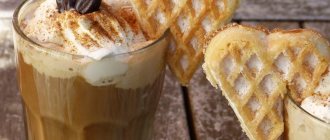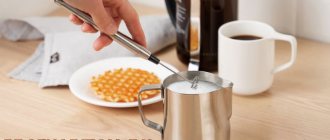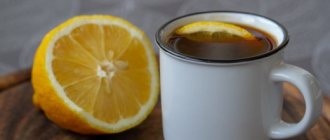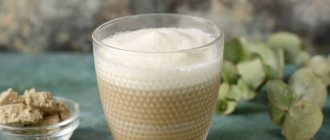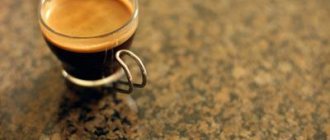Early morning in St. Peter's Square in Rome, melodious Italian speech, a bagel with marzipan and almonds and, of course, a cup of hot aromatic cappuccino with sweet foam - a symbol of the beginning of the day, Italian carefreeness and good mood. And even though Italy is far away, this drink is good both on a Moscow spring day and on a quiet evening in the village in the company of homemade sweet pies.
We will tell you everything we know about the world's favorite coffee drink with milk, and teach you how to prepare it at home without a cappuccino maker.
What or nothing to do with the Capuchin monks? The real history of cappuccino
Despite existing tales that its recipe was invented by the Capuchin monks, and despite the Italian sound of the name, the predecessor of modern cappuccino appeared in Austria in the 18th century.
The drink made from coffee, whipped egg whites and cream was called “Kapuziner”. The name was indeed associated with the Capuchins: the creators of the drink thought that its color was similar to the brown robe of monks. By the way, the second name for coffee, popular at the beginning of the 18th century, sounded like Franziskaner (and the Capuchin Order was one of the branches of the Franciscan Order). From Austria, capuchiner came to the northern border regions of Italy, and from there it spread throughout the country, receiving the Italian form of the name - cappuccino.
Until the beginning of the 20th century, milk and cream for cappuccino were whipped by hand (we will also teach you how to do this a little later). It is known that the first primitive mechanical cappuccino maker, which greatly speeds up the whipping process, appeared a little more than 100 years ago, but information about its creator remains very contradictory. One way or another, already in the early 30s of the 20th century, coffee with foamed milk, decorated with cinnamon or chocolate, was widely served in Italian coffee shops. And then everything went like clockwork. Immigrants from post-war Italy in the 1940s brought their love of cappuccino to the United States, where it became especially popular in Boston, New York and San Francisco: three cities that set trends (including culinary trends).
Technology for creating cappuccino in a coffee machine
To properly prepare a real Italian cappuccino, you need to use a certain amount of ingredients. Coffee should take up no more than one third of the cup's volume. The rest of the part is filled with whipped cream.
Real cappuccino is obtained if the following requirements are met:
- Espresso must be brewed separately.
- The milk product is whipped until a large amount of foam is obtained. Milk itself is not added to the drink under any circumstances; only foam is used.
- Ideally, espresso should be prepared at the same time as the milk is frothed. The ingredients are combined after they have warmed up to the same temperature.
A real cappuccino has the following properties:
- If you move the foam to the side with a spoon, it will take its initial position without losing its integrity.
- The milk cap is located on the surface in a dense, even layer, without forming a slide.
- There is no pronounced bitterness or sourness, the appearance of which indicates the use of a low-quality coffee product or an incorrectly selected proportion.
How it all works: the simplest cappuccino recipe
The traditional Italian cappuccino recipe called for the following proportions: ⅓ espresso, ⅓ warm milk and ⅓ 1 cm high frothed milk. But back in the 20th century, baristas began experimenting with the amount of milk and foam, so cappuccino in two nearby coffee shops can taste completely different.
The coffee base for a standard cup of cappuccino is 1 serving of espresso (30 ml) or 2 servings (60 ml, but then 2 times more milk is taken).
The regular cappuccino has a “summer” cousin - the Freddo cappuccino, created on the basis of already chilled espresso, to which cold foamed milk has been added. The Greek version is called freddo cappuccino (yes, the Greeks just rearranged the words) and features espresso (or any other coffee, including instant) chilled with ice and topped with foam.
Several other drinks have been created based on cappuccino: for example, a non-alcoholic coffee cocktail bicherin with hot chocolate (milk replaced with cream), marocino with cocoa, spicy cappuccino and even babycino - a children's version of cappuccino that uses either decaffeinated coffee or cocoa , or just milk and sweet, airy milk foam.
Cappuccino: difference from other coffee recipes
A cappuccino recipe is one of the options for coffee-containing drinks, of which there are a great variety. What is the difference between the most popular traditional coffee menu recipes?
What is the difference between a cappuccino and a latte?
- Proportions. A latte contains much more milk than a cappuccino. A latte contains only 1/5 coffee and 4/5 milk.
- Cooking method. A latte is made by adding coffee to milk. To make cappuccino, on the contrary, milk is poured into coffee.
- Volume. A latte serving is approximately 350-380 ml, sometimes more. Cappuccino is served in portions from 180 to 250 ml.
- The latte tastes milky and sweet. The influence of coffee on the bouquet of the drink is minimal. The taste of cappuccino is coffee and milk, the coffee in it is felt brightly.
What is the difference between a cappuccino and a mochaccino?
- Compound. Mochaccino, in addition to coffee and milk, includes chocolate syrup or hot chocolate.
- Proportions. Mochaccino contains approximately ¼ part coffee and ¾ other ingredients. Compared to cappuccino, the share of coffee is reduced.
- Cooking method. In mochaccino, coffee is added after milk and chocolate, unlike cappuccino.
- Taste. The bouquet of mochaccino is chocolate-milk, sweet, with coffee notes, it differs from the coffee-milk taste of cappuccino.
What is the difference between a cappuccino and an Americano?
- Compound. Americano does not have foamed milk or a high head of foam; only espresso, heavily diluted with water, is used to make it.
- Taste. Americano has a weakened coffee taste, without the dairy component. Even if Americano is diluted with milk, it will be very different from the bright coffee and milk flavor of cappuccino.
What is the difference between cappuccino and espresso?
- Compound. Espresso is coffee brewed in an automatic coffee machine. Prepared without additives, it is the basis for many other coffee drinks, including cappuccino.
- Volume. A serving of espresso ranges from 40 to 80 ml. A cappuccino has a volume of at least 150 ml and can go up to 250 ml.
What is the difference between a cappuccino and a macchiato?
- Proportions. Macchiato, like cappuccino, contains foamed milk, but in much smaller quantities. The classic macchiato recipe is 1/3 milk and 2/3 coffee, while a cappuccino is 1/3 coffee and 2/3 milk.
- Taste. Milk in a macchiato only emphasizes the bouquet of coffee, while milk in a cappuccino significantly softens the harshness of the coffee, blurring the richness of the coffee.
- Cooking method. To obtain a macchiato, coffee is poured into a small portion of frothed milk to create the characteristic coffee stains on the surface of the foam, which give the drink its name. "Macchiato" means "spotted" in Italian.
What is the difference between cappuccino and coffee with milk?
- Cooking method. For cappuccino, milk is frothed using a blender or cappuccino maker.
- Compound. In cappuccino, approximately 1/3 is delicate milk foam, which gives the drink a special taste and recognizable appearance. Coffee with milk does not contain whipped foam.
- Proportions. The milk component for coffee with milk can be anything - half a cup or one tablespoon. The proportions of a classic cappuccino are regulated: 1/3 milk, 1/3 coffee, 1/3 milk foam.
What is the difference between cappuccino and raf coffee?
- Compound. Rough coffee is made from cream, coffee and sugar. The composition of cappuccino is milk and coffee, cream is used much less frequently, and sugar is added as desired.
- Cooking method. To prepare raf coffee, all ingredients are mixed and whipped. For cappuccino, only milk is frothed.
How to choose coffee for cappuccino
Historically in Italy, baristas used dark roasted Arabica and Robusta blends to prepare espresso and espresso-based drinks. In this case, milk softened the bitter taste.
But everything changed with the light hand of the queen of specialty Erna Knutsen, who introduced the fashion for the natural fruity taste of coffee. Coffee shops began to brew espresso using pure Arabica, and their visitors began to learn to detect subtle notes of chocolate, spices, cherries and apricots.
However, don’t worry if you don’t like sourness in your coffee. For cappuccino, everyone also uses blends of Arabica or Arabica and Robusta with a neutral taste, since high acidity does not combine well with milk. The best beans for cappuccino with notes of nuts, cocoa and caramel come from Brazil, Vietnam, Honduras, etc.
How to make cappuccino from instant coffee?
If you don’t have a Turk or coffee maker in your house, then cappuccino can be made from instant espresso. Of course, true cappuccino connoisseurs may be offended by this approach to the drink, but, as they say, “no fish, no fish.” To prepare ersatz cappuccino you will need:
- Instant coffee – 2 tsp;
- Sugar – 2 tsp;
- Milk – 100 ml;
- Water – 100 ml.
Beat lukewarm milk in a mixer or blender. Add sugar to a cup of coffee powder and add hot water. Transfer the finished foam into a cup with instant coffee drink. If necessary, you can sprinkle grated dark chocolate or cinnamon on top.
A classic that will always be in fashion
According to baristas, cappuccino will never go out of style due to its versatility. This drink is a compromise between the bright, brutal expressiveness of espresso and sweet coffee drinks such as latte or raffa, which is fashionable in Russia.
The taste of cappuccino is influenced by two components - coffee and milk, and the milk must be of really high quality and suitable fat content. Good milk can “pull out” grain of average quality (but this relationship does not work the other way around).
Cappuccino with cow's milk
Cappuccino with cow's milk is a classic that can be found in any cafe from Moscow to Kamchatka. A traditional cappuccino, balanced in taste, cannot be sour or bitter, but it should have a sweetish taste without added sugar due to the natural sweetness of milk.
The ideal foam should be elastic, silky, consisting of microbubbles without large air bubbles, not scalding hot, but not cold either. The sweet taste is provided by lactose, which, when heated, breaks down into monosaccharides - glucose and galactose, and the proteins contained in milk are responsible for the pleasant texture.
For proper cappuccino, a high percentage of protein content is required. But high fat content is not necessary (and even harms the taste).
Cappuccino with plant milk
New times dictate new rules, and for those who for some reason do not accept cow's milk in their coffee, baristas have begun making cappuccino with plant-based milk. For example, coconut, soy, almond or even oatmeal. Each of these products has its own nuances of use: soy and coconut products should not be poured into a freshly prepared drink, as their protein coagulates due to high temperatures (above 60 °C), and almond products begin to taste bitter due to excessive heating.
Read more about plant milk in coffee in our article.
conclusions
- It is recommended to drink cappuccino in the first half of the day, take care of your health.
- Do not drink cappuccino after a heavy meal; the drink contains a portion of milk, and milk is equivalent to food.
- The cup should be warmed up, and the coffee in it should be 60-70 degrees. Tall glasses are not suitable for proper cappuccino.
- Drink coffee immediately after preparation, do not wait until it cools down.
- Do not stir the drink, start drinking straight from the thick foam. Let it harden on your lips and you will feel how nice the air bubbles burst.
Cappuccino, latte and flat white: twins or different drinks?
The difference between cappuccino, latte and flat white, which are so similar at first glance, is a topic for a separate article. In short, these are not just different drinks, but very different.
Cappuccino is based on one third espresso and two thirds milk. This makes its taste both milky and round and coffee-like.
The history of latte, or more precisely latte macchiato (“latte” means “milk” in Italian), is a little comical. It was invented as a kind of children's drink. Italian women were concerned that their children were also drinking undiluted espresso. Someone came up with the idea of adding milk to coffee—lots of milk. Over time, the latte recipe has evolved, but the main thing remains the same: coffee makes up only ¼ of the drink, the rest is milk. The foam is also different: in latte it is more airy and loose, in cappuccino it is dense, with micro-bubbles of air.
But flat white, on the contrary, is coffee for those strong in spirit and body. It appeared in New Zealand, and there were at least two reasons for this. Firstly, the country is home to many descendants of Italian and Greek immigrants who brought their love of strong coffee from Europe. And secondly, because the milk of New Zealand cows is too fatty and produces too much foam. Experimental bartenders reduced the amount of milk, and at the same time doubled the amount of coffee: a standard flat white contains 2 servings of espresso. Which, without a doubt, makes it the strongest of all coffee milk drinks.
We wrote in more detail about the origin of flat white and its differences from cappuccino and latte in our article.
What is the “correct” cappuccino in the context of an automatic coffee machine, and why is it important to know?
A proper cappuccino (by the way, it is neuter) is simply a cappuccino according to the classic recipe. It’s just that the sequence of adding ingredients to the cup is important: first espresso (ristretto or double espresso is also allowed), and then frothed milk.
It would seem, why then do I even call it correct, and even focus on this, if this is just an original Italian recipe? We are talking specifically about automatic grain coffee machines.
The fact is that even now the vast majority of home models with an automatic cappuccino maker mean something different by the “cappuccino” program. They first froth and add milk to the cup, and only then coffee. So they actually make a different drink, the latte macchiato. But the recipe is called “cappuccino,” which confuses users. Moreover, in programs called “latte”, these same models make not a latte, but a latte macchiato, only with different proportions of coffee and milk.
Evaluate the process and result of a typical “wrong” cappuccino: the drink is flaky, with milk foam on top without the slightest presence of coffee cream.
It turns out to be a paradox. Almost all coffee machines with an automatic cappuccino maker, which have a cappuccino program and prepare it in one click, do not make cappuccino using this program. And those models that still know how to pour first espresso and then milk for any recipe call it some alternative names, starting from Cafe au lait (Philips) and ending with all sorts of Cappuccino Mix (Delonghi). And the program under the name “cappuccino” works just as crookedly for them as for the others - this is apparently a tribute to continuity.
Just three years ago, coffee machines that would have a program with the correct dispensing sequence under any name could be counted on the fingers of one hand. Now manufacturers have finally realized the importance of such a drink, and more and more coffee machines are equipped with this valuable program.
List of coffee machines that can produce proper cappuccino in one click, as of May 2021.
And although I do not consider capsule coffee makers to be coffee machines, for the sake of completeness I will add that there is an exception among them - it works with real milk and can make the right cappuccino in one click Nespresso Delonghi EN560 Lattissima Touch Animation. Here are Gran Lattissima and Lattissima Pro.
Below is a video example of cooking with the correct sequence:
How to make proper cappuccino if there is no special program for it?
On any or almost any coffee machine with an automatic cappuccino maker, you can froth milk separately, without dispensing coffee, and store the required volume of milk in memory. There are exceptions, of course. For example, Philips 3200 Series, but it’s still possible there, in the review I described how. So, you can make the right cappuccino in two steps:
- First, start the espresso (ristretto/double espresso) process.
- Then start the milk frothing process in the same cup.
Not in one click, but the desired drink is ready.
- Cappuccino coffee: composition, types and recipes
How to make cappuccino at home
In the coffee machine...
If you have a coffee machine with a cappuccino maker in your kitchen, the whole process is to brew espresso, pour milk into a pitcher (a special metal milk jug) and whisk it until microbubbles appear, and then pour it into a cup. In this case, it is better to follow a few rules.
- The milk should initially be cold. Before you start whipping, you need to warm it up for 20–30 seconds, placing it under the steam wand of the coffee machine, and only then beat it until the pitcher becomes hot. If you have a kitchen thermometer, everything becomes even simpler. The milk and foam in the pitcher should reach 65 degrees. All that remains is to carefully pour it into the already prepared espresso.
- The cappuccino cup must be preheated so that the coffee can better reveal its flavor.
And without a coffee machine...
If the only coffee equipment in your house is a geyser coffee maker, a cezve or a French press, don’t be upset. Making cappuccino at home is quite possible, even if you don't have a coffee machine. The main thing is to have a mixer (or the same French press).
First you need to brew coffee in a way convenient for you. The volume of coffee can be any, but it is important to maintain classic proportions, although this is also a matter of taste. On the Internet there are recipes for double homemade cappuccino, which is prepared using 60 ml of coffee and 80 ml of milk.
You can froth milk with a manual frother (the famous home frother from IKEA costs about 100 rubles and only requires regular battery changes) or with a mixer. There is another way: heat the milk to 70 degrees, pour it into a French press (no more than 1/3 of the flask), and then quickly raise and lower the piston for 35–40 seconds. With a final circular motion, mix the foam and milk into a homogeneous mass, and then pour into a cup.
Watch how our expert tester Andrey Skidan does it:
Cappuccino composition
True gourmets and coffee connoisseurs will never drink an instant drink brewed from a bag. Although manufacturers write the word “cappuccino” on the packaging, you shouldn’t expect it there as such. The composition of such a bag is more similar to the periodic table, which cannot be said about real cappuccino coffee.
The correct, aromatic drink is prepared according to a special recipe from milk and black coffee. The correct proportions and temperature conditions play a significant role in this. It is necessary to mix coffee and milk in equal proportions.
Sometimes milk is replaced with cream or plant milk. Also an integral part is the whipped milk foam that decorates the drink. Many baristas also add a pattern to it using cinnamon or cocoa.
The standard cappuccino includes 45 ml of espresso brewed from ground beans, milk and foam. You can also add sugar, cinnamon, vanilla, chocolate, caramel, liqueur and other additives - to taste. They add an unusual and pleasant taste, don't be afraid to experiment and try something new. After all, this will only delight your taste buds and diversify your usual drink.
Not only tasty, but also beautiful: latte art as art
“Just cappuccino”, which we take “with us” in paper cups, is often tasty, but its beauty under the lid is impossible to see. But in coffee shops, cappuccino is most often served with a design on the milk foam. The art of creating drawings on foam is called latte art.
There are only two latte art techniques - pitching (drawing with a stream of milk) and etching (drawing with improvised means like syrups and cinnamon). Etching is a purely professional area for barista-artists who compete with each other at latte art championships. And pitching is a fairly simple technique in which absolutely all compositions are created based on three patterns: a tulip, a heart and a rosette. We have already written more about latte art and how to learn to draw on foam at home in our article.
Latte art has one special feature. Despite all the beauty of the created picture, the integrity of the foam is compromised. The coffee cream ring that appears when drawn gives the drink a little more bitterness, while a cappuccino without latte art is considered more balanced in taste.
Healthy harmful cappuccino
To be honest, we didn’t want to write this, but cappuccino is a vivid example of how you can also say about coffee “but it’s beautiful.” Moderate consumption of this drink will not cause harm to the body, but you should not expect the benefits that any black coffee provides from it.
So, the cons
- The milk protein casein reacts with coffee polyphenols and partially destroys them. And polyphenols, by the way, are the most important beneficial substances in coffee. They act as antioxidants and protect cells from free radicals.
- Cappuccino, like any other coffee with milk, takes longer to digest in the stomach.
- Cappuccino has calories. The energy value of a cup without added sugar is 33.45–37.65 kcal, and with the addition of a couple of spoons of sugar it is already 52.80–57.00 kcal. For comparison, the calorie content of espresso is only 2 kcal.
pros
- Caffeine is here to stay. No, milk does not neutralize it, this is a myth. A cappuccino contains exactly the same amount of caffeine as a cup of espresso, which became its basis. Therefore, if you need coffee to wake up and “pump up” in the morning, cappuccino is more than suitable.
- Cappuccino with plant milk can be a solution for those who want to both improve their health and get their favorite foam. Plant proteins do not destroy coffee's antioxidants. True, there are still problems with the calorie content of cappuccino with coconut or almond milk.
How to drink cappuccino correctly?
The ideal way to drink cappuccino is to drink it without stirring, passing the coffee and milk through a layer of airy foam. In order to avoid mixing, sweet toppings were added to cappuccino for those with a sweet tooth.
Some skim off the foam with a spoon and only then start drinking coffee. This is not entirely correct, since with this use there is no opportunity to enjoy a real bouquet of cappuccino.
According to gourmets, sugar spoils the taste of cappuccino, so coffee lovers do not put any sweeteners in their cappuccino. Silky foam and milk sufficiently soften the coffee bitterness.
Italians believe that cappuccino time is morning until noon, or better yet, before 11 o’clock. They do not advise drinking it after meals, as milk slows down and impairs digestion.
You need to know this to shine over a cup of cappuccino
Some statistics. In October 2021, the analytical company Nielsen, together with IT, conducted a study of the “portrait” of the average visitor to Moscow coffee shops. As a result, it turned out, firstly, that the peak of coffee sales occurs from 6 a.m. to 12 noon, and secondly, that the leader among drinks is cappuccino. It is preferred by 45% of visitors. It is followed by a latte with 20%, an Americano with 10%. Raf scored 8%, and the most popular espresso in Italy in Russia is preferred by only 4% of coffee lovers. The remaining positions were taken by flat white and other drinks.
In Italy, cappuccino is a breakfast drink; for the rest of the day, there is espresso. For a long time it was believed that asking a Roman barista to make a cappuccino in the afternoon was an almost mortal insult. They say that the barista will refuse, passionately explaining in Italian why this cannot be done. In fact, nothing bad will happen, and this rule does not apply to tourists. The Italians themselves really do not drink dairy drinks after lunch, considering them hard on the stomach.
There is a popular meme in the coffee community that when a coffee shop visitor eats cappuccino foam with a spoon, somewhere a barista is crying. It’s not a matter of professional snobbery (although there is that too), but the taste of cappuccino is determined precisely by the first sip, when the silky texture of the still intact foam, sweet milk and coffee act in tandem. But, on the other hand, our experts have repeatedly said that the best coffee is the one you like.
Finally, about serving the drink. Cappuccino is not served in glass containers. If the material is ceramics or thick-walled porcelain that holds heat well. If the shape is a classic demitasse with rounded edges, volume 150–180 ml. The temperature of the drink should be 60–65 degrees.
How many cups of cappuccino do you drink a day?
Cappuccino: our conclusion
- A coffee drink with the addition of frothed milk and a high, cone-shaped head of foam.
- It has an average calorie content and strength, the invigorating effect is reduced due to the partial neutralization of caffeine by milk.
- The main taste is coffee-milk, pronounced.
- It's better to drink without sugar.
- The optimal time for consumption is before 11 am.
- It has a number of differences from other recipes for coffee-containing drinks.
- The most popular drink in European and American coffee shops.



